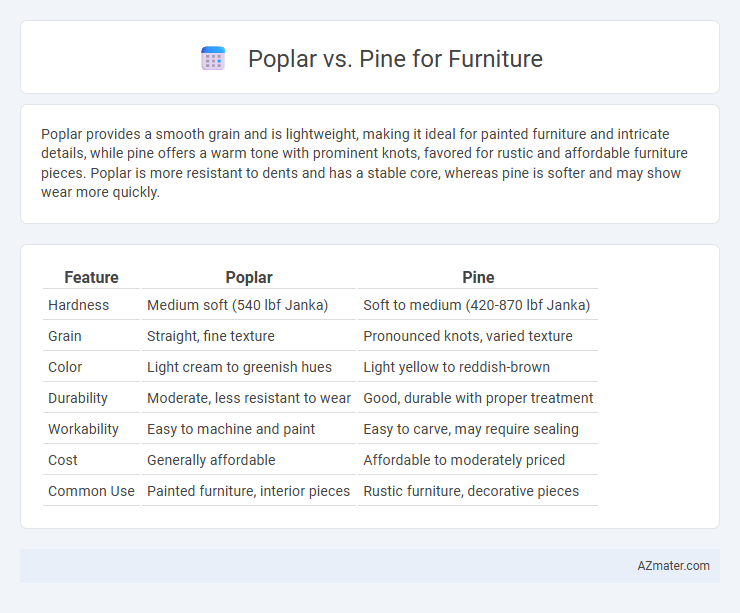Poplar provides a smooth grain and is lightweight, making it ideal for painted furniture and intricate details, while pine offers a warm tone with prominent knots, favored for rustic and affordable furniture pieces. Poplar is more resistant to dents and has a stable core, whereas pine is softer and may show wear more quickly.
Table of Comparison
| Feature | Poplar | Pine |
|---|---|---|
| Hardness | Medium soft (540 lbf Janka) | Soft to medium (420-870 lbf Janka) |
| Grain | Straight, fine texture | Pronounced knots, varied texture |
| Color | Light cream to greenish hues | Light yellow to reddish-brown |
| Durability | Moderate, less resistant to wear | Good, durable with proper treatment |
| Workability | Easy to machine and paint | Easy to carve, may require sealing |
| Cost | Generally affordable | Affordable to moderately priced |
| Common Use | Painted furniture, interior pieces | Rustic furniture, decorative pieces |
Introduction to Poplar and Pine Wood
Poplar wood is a lightweight hardwood known for its fine, even texture and pale color, making it ideal for painted furniture and interior woodworking projects. Pine, a softwood with distinct grain patterns and knots, offers affordability and ease of staining, commonly used in rustic and country-style furniture. Both woods provide versatile options, but poplar's smooth finish contrasts with pine's natural, knotty appearance.
Botanical and Physical Characteristics
Poplar (genus *Populus*) features a lightweight, fine-grained wood with a pale yellow-green to creamy white color, offering smooth workability and moderate strength, making it ideal for painted furniture. Pine (genus *Pinus*), characterized by its softwood with distinct resin canals and a warm yellow to reddish-brown hue, exhibits higher resin content and knots, providing durability and a rustic appearance suited for solid wood furniture. Both species differ botanically as poplar is a deciduous hardwood, while pine is a coniferous softwood, influencing their respective density, hardness, and finishing qualities in furniture applications.
Workability and Ease of Use
Poplar wood offers excellent workability due to its fine, even texture and softness, making it easy to cut, shape, and sand, ideal for detailed furniture projects. Pine is also user-friendly but tends to be softer and more prone to dents and scratches, requiring careful handling during assembly and finishing stages. Poplar's stable grain minimizes warping, whereas pine may require additional treatment to prevent deformation over time in furniture applications.
Appearance and Grain Patterns
Poplar wood features a light, creamy color with subtle green or gray hues, offering a smooth, uniform grain that is typically straight and fine-textured, making it ideal for painted furniture. Pine displays a warmer golden to reddish tone with prominent knots and more pronounced, irregular grain patterns that add rustic character to furniture pieces. While poplar provides a clean, modern look suitable for sleek designs, pine's distinct grain and natural imperfections lend a traditional, cozy aesthetic.
Durability and Strength Comparison
Poplar wood offers moderate durability and strength, making it suitable for lightweight furniture but less ideal for high-stress applications. Pine, particularly Southern Yellow Pine, provides greater hardness and resistance to wear, delivering better performance in furniture subjected to regular use and pressure. Durability in pine also benefits from natural resin content, which enhances its toughness compared to the softer, more easily dented poplar.
Cost and Availability
Poplar wood offers a more cost-effective option for furniture compared to pine, with prices generally lower due to its faster growth rate and abundance in North America. While pine is widely available and popular for furniture making, it tends to be pricier because of its durability and distinctive grain patterns. Availability of both woods is region-dependent, but poplar's extensive cultivation results in consistently stable supply and affordability.
Suitability for Different Furniture Types
Poplar wood excels in medium-density furniture like cabinets, painted surfaces, and indoor pieces due to its smooth texture and workability. Pine, with its knotty character and natural durability, is ideal for rustic furniture, children's furniture, and pieces where a natural finish is desired. While poplar offers a more uniform appearance suitable for finishes and veneers, pine's strength and visual warmth make it better for structural and decorative items.
Staining, Painting, and Finishing Considerations
Poplar wood offers excellent stain absorption, producing a smooth, uniform finish that highlights its fine grain, making it ideal for projects needing vibrant or dark stains. Pine, with its pronounced knots and resin pockets, can absorb stain unevenly, often requiring a pre-conditioner or paint to achieve consistent color and finish. When painting, pine's texture and resin content allow for strong adhesion and a rustic look, while poplar's smooth surface supports a sleek, professional paint finish, simplifying the sanding and sealing process for both woods.
Environmental Impact and Sustainability
Poplar wood is considered more sustainable than pine due to its faster growth rate and higher yield per acre, which reduces pressure on natural forests. Pine trees, while also renewable, often require longer growth periods and can be sourced from monoculture plantations that may impact biodiversity negatively. Choosing poplar furniture supports lower carbon footprints and promotes responsible forestry practices, making it a more eco-friendly option.
Poplar vs Pine: Which is Better for Furniture?
Poplar offers a lightweight, smooth grain that is easy to paint and shape, making it ideal for intricate furniture designs and budget-friendly projects. Pine, known for its durability and rustic charm, features prominent knots and a warm color that enhances farmhouse and traditional styles. Choosing between poplar and pine depends on whether you prioritize a sleek, paintable surface or a sturdy, natural wood appearance for your furniture.

Infographic: Poplar vs Pine for Furniture
 azmater.com
azmater.com